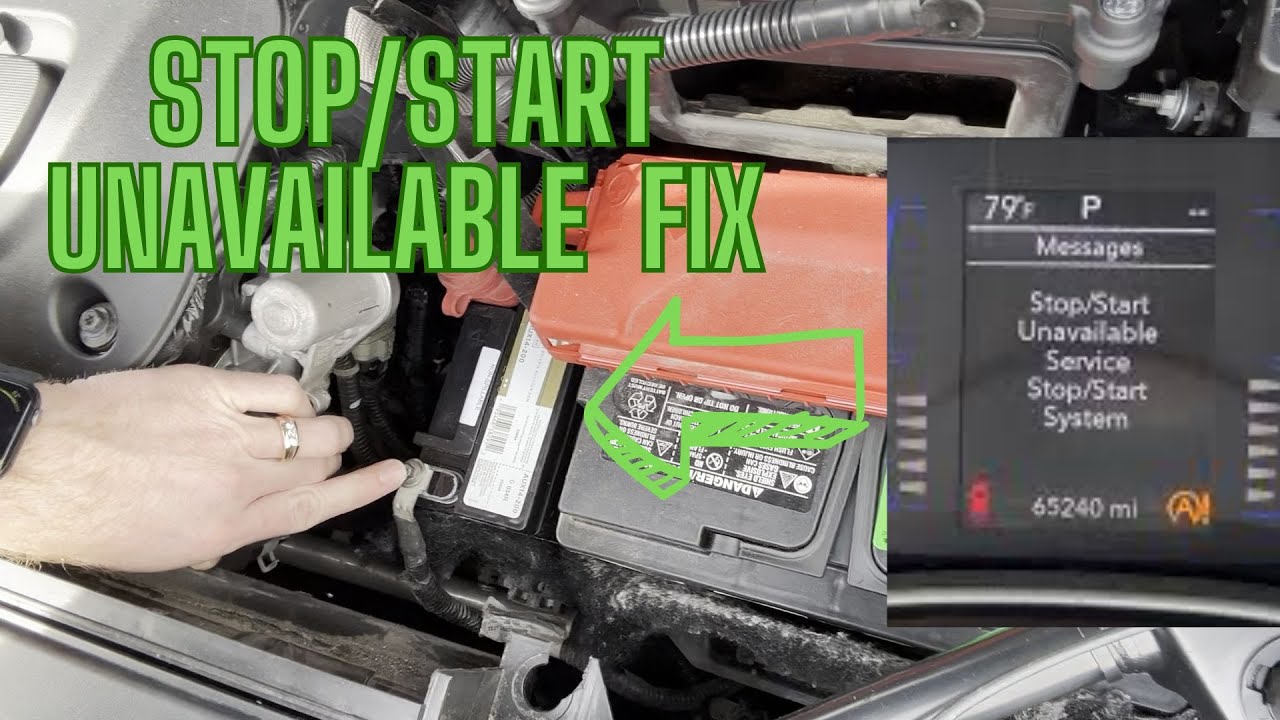The Stop/Start Unavailable Service indicates an issue with your vehicle’s Stop/Start system. This malfunction can stem from various causes.
The Stop/Start system in vehicles is designed to improve fuel efficiency by automatically shutting down the engine when the vehicle is idle and restarting it when needed. This feature is beneficial for reducing emissions and saving fuel. However, if you receive a “Stop/Start Unavailable Service” message, it could mean there is a fault in the system.
Common reasons include low battery voltage, sensor malfunctions, or software glitches. Regular maintenance and timely diagnostics are crucial to ensure the Stop/Start system functions properly. Addressing these issues promptly can help maintain the performance and efficiency of your vehicle.
Common Issues
The Stop/Start system in modern vehicles helps save fuel and reduce emissions. Yet, many drivers encounter common issues with this system. These problems can hinder its performance and efficiency. Let’s explore some of the most frequent issues.
Battery Problems
Battery problems are a significant cause of Stop/Start system failures. This system relies heavily on the vehicle’s battery. If the battery is weak or old, the system may not work properly. Here are some common battery-related issues:
- Low Battery Charge: The system needs a fully charged battery. A low charge can prevent it from functioning.
- Battery Age: Old batteries may not support the Stop/Start system. Consider replacing the battery if it’s more than three years old.
- Temperature Sensitivity: Extreme temperatures can affect the battery’s performance. Cold weather can reduce its efficiency.
Sensor Malfunctions
Sensors play a crucial role in the Stop/Start system. They monitor various aspects of the vehicle. If a sensor fails, the system may not operate correctly. Here are some common sensor-related issues:
- Faulty Brake Sensor: The system relies on the brake sensor. If it malfunctions, the system may not engage.
- Engine Temperature Sensor: This sensor ensures the engine is at an optimal temperature. A faulty sensor can prevent the system from working.
- Battery Sensor Issues: The battery sensor monitors the battery’s health. If it fails, the system might not function properly.
Addressing these common issues can help maintain your Stop/Start system’s efficiency. Regular maintenance and checks are essential for optimal performance.

Diagnosing The Problem
Diagnosing issues with the Stop/Start System can be challenging. This system is designed to save fuel and reduce emissions. A malfunction can cause inconvenience and inefficiency. Let’s explore how to diagnose the problem effectively.
Initial Checks
Start with basic checks to identify obvious issues. Ensure the battery is in good condition. A weak or dead battery can disable the system. Check if the engine is overheating. Overheating can also disable the Stop/Start function. Examine the brake pedal sensor. A faulty sensor can prevent the system from working.
- Ensure battery health
- Check for engine overheating
- Inspect brake pedal sensor
Using Diagnostic Tools
Advanced diagnostic tools can provide more detailed insights. Use an OBD-II scanner to read fault codes. These codes can pinpoint specific issues. Follow these steps to use an OBD-II scanner:
- Plug the scanner into the OBD-II port.
- Turn on the vehicle’s ignition.
- Read and record the fault codes.
- Interpret the codes using the scanner’s manual.
If necessary, consult a professional mechanic. They have advanced tools and expertise.
| Common Issues | Possible Solutions |
|---|---|
| Weak Battery | Replace or recharge the battery |
| Faulty Brake Pedal Sensor | Inspect and replace the sensor |
| Engine Overheating | Check coolant levels and fans |
Battery Maintenance
Proper Battery Maintenance is crucial for the efficiency of your Stop/Start System. A well-maintained battery ensures smooth operation and prevents service interruptions. This section will guide you through the essentials of keeping your battery in top shape.
Checking Battery Health
Regularly checking the battery health is vital. Use a voltmeter to measure the battery’s voltage. A fully charged battery should read between 12.6 and 12.8 volts. If the reading is lower, your battery may need charging or replacement.
Inspect the battery terminals for corrosion. Clean any build-up using a mixture of baking soda and water. Ensure the connections are tight and free from rust.
- Check voltage with a voltmeter.
- Inspect for corrosion.
- Clean terminals with baking soda solution.
- Ensure tight connections.
Replacing The Battery
If your battery fails the health check, it’s time for a replacement. Use the correct battery type specified for your vehicle. An incorrect battery can affect the Stop/Start System.
Follow these steps to replace the battery:
- Turn off your vehicle.
- Disconnect the negative terminal first.
- Disconnect the positive terminal.
- Remove the old battery.
- Place the new battery in the tray.
- Reconnect the positive terminal first.
- Reconnect the negative terminal.
- Ensure all connections are secure.
After replacing, test the new battery with a voltmeter. Ensure it reads between 12.6 and 12.8 volts.
Maintaining your battery ensures the Stop/Start System works efficiently. Regular checks and timely replacements are key.
Sensor Troubleshooting
The Stop/Start system in vehicles helps save fuel and reduce emissions. Sometimes, this system may show an “Unavailable” message. Troubleshooting sensors can often resolve this issue. Let’s dive into the process of inspecting and calibrating these sensors.
Inspecting Sensors
First, locate all the sensors connected to the Stop/Start system. Check the wiring and connections for any visible damage. Ensure all connectors are firmly attached. A loose wire can cause a sensor to fail.
Use a multimeter to test the sensors. Measure the voltage to see if they are receiving power. Compare the readings to the manufacturer’s specifications.
If the readings are off, the sensor might be faulty. Replace it with a new one. Always use sensors recommended by the vehicle manufacturer.
Calibrating Sensors
After inspecting, you might need to calibrate the sensors. Calibration ensures the sensors give accurate readings. Follow these steps:
- Turn the ignition off and disconnect the battery for safety.
- Reconnect the battery and turn the ignition on.
- Use a diagnostic tool to access the sensor settings.
- Follow the tool’s instructions to calibrate each sensor.
Some vehicles might require a drive cycle to complete calibration. Drive the car as specified in the manual. This ensures the sensors adapt to real-world conditions.
Regular maintenance keeps the Stop/Start system working efficiently. Inspect and calibrate sensors periodically. This helps maintain optimal performance and fuel savings.
Software And Firmware Updates
The Stop/Start System in your vehicle relies on software and firmware. These updates improve performance and fix bugs. Keeping your system updated ensures it runs smoothly. Here’s how to check and install updates.
Checking For Updates
To check for updates, follow these steps:
- Turn on your vehicle.
- Access the main menu on the infotainment screen.
- Select Settings from the menu.
- Look for the Software Updates option.
- Choose Check for Updates.
If an update is available, you will see a notification. Keeping your system updated prevents many issues.
Installing Updates
Once you have checked for updates, it’s time to install them. Follow these steps:
- Ensure your vehicle is parked safely.
- Connect your vehicle to a stable Wi-Fi network.
- Go to Settings on the infotainment screen.
- Select Software Updates.
- Click on Install Updates.
- Wait for the installation process to complete.
Do not turn off your vehicle during the update. It may take a few minutes, so be patient. Your vehicle will notify you once the update is complete.
Benefits Of Keeping Software Updated
Updating your software and firmware comes with many benefits:
- Improved performance
- Enhanced security
- Bug fixes
- New features
Always keep your Stop/Start System up to date. It ensures you get the best performance from your vehicle.

Professional Help
When your vehicle’s Stop/Start System becomes unavailable, it may be time to seek professional help. This system is crucial for fuel efficiency and reducing emissions. Understanding when to consult a mechanic and choosing the right service center can save you time and money.
When To Consult A Mechanic
Several signs indicate that your Stop/Start System needs professional attention:
- Warning Lights: If the Stop/Start warning light is on.
- System Inactivity: The system does not activate at stops.
- Strange Noises: Unusual sounds when the system should activate.
These issues often require a mechanic’s expertise. Regular maintenance can help, but professional diagnosis ensures safety and efficiency.
Choosing The Right Service Center
Finding the right service center is crucial. Consider these factors:
| Factor | Details |
|---|---|
| Experience | Check if they have experience with Stop/Start Systems. |
| Certifications | Look for certified mechanics and service centers. |
| Customer Reviews | Read reviews to gauge service quality. |
| Warranty | Ensure they offer warranties on their work. |
Following these tips can help you find a reliable service center. This ensures your Stop/Start System is in expert hands.
Preventive Measures
Maintaining the Stop/Start system in your vehicle is crucial. Preventive measures ensure the system works efficiently. Here are some steps to help you keep it in top condition.
Regular Maintenance Tips
Regular maintenance is key. Follow these tips to keep your Stop/Start system running smoothly:
- Check the battery regularly. A weak battery can disable the system.
- Inspect the alternator. It should be in good condition to support the battery.
- Clean the battery terminals. Dirt and corrosion can affect the system.
- Monitor the brake pads. Worn pads can interfere with the system.
- Check the engine oil level. Low oil can trigger a system shutdown.
Keeping Software Updated
Software updates are vital. They often include improvements and bug fixes. Here are some tips to ensure your software is up-to-date:
- Check for updates regularly. Visit the manufacturer’s website or your car’s dashboard.
- Install updates as soon as they are available. This helps keep the system efficient.
- Visit your dealer. They can perform updates and check the system.
- Use a diagnostic tool. This helps identify any software issues early.
By following these preventive measures, you ensure the longevity of your Stop/Start system. Regular maintenance and software updates are essential. Keep your system in top shape and enjoy a smoother driving experience.
Frequently Asked Questions
What Does Stop-start Unavailable Service Stop-start System Mean?
The “stop-start unavailable service stop-start system” means the vehicle’s stop-start feature is temporarily disabled due to specific conditions. These conditions could include low battery, extreme temperatures, or engine issues. This system helps save fuel by shutting off the engine during idle periods.
How To Fix Stop-start System Warning Light?
To fix the stop-start system warning light, check the battery, inspect fuses, and ensure all sensors are clean. Consult the vehicle manual for specific guidance. If the issue persists, visit a professional mechanic for diagnosis and repair.
Why Is My Stop-start Technology Not Working?
Your stop-start technology may not work due to a low battery, extreme temperatures, or seatbelt not fastened.
What Causes Start-stop System Fault?
A start-stop system fault can be caused by a weak battery, faulty sensors, or software glitches. Other common causes include wiring issues, low engine temperature, and malfunctioning alternators. Regular maintenance helps prevent these issues.
Conclusion
Mastering the Stop/Start system can boost your vehicle’s efficiency. Understanding its workings and troubleshooting common issues is essential. Regular maintenance ensures optimal performance. Embrace these tips to enjoy a smoother driving experience and save on fuel costs. Stay informed and keep your vehicle running efficiently for years to come.

